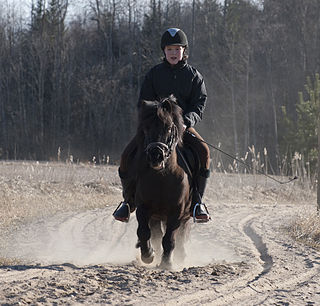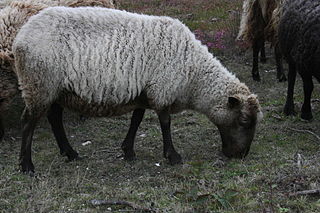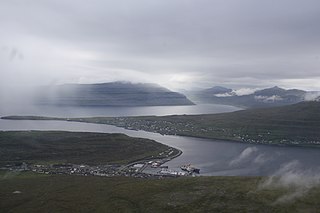The domestic animals of the Faroe Islands are a result of 1200 years of isolated breeding. As a result, many of the islands' domestic animals are found nowhere else in the world.
Contents

The domestic animals of the Faroe Islands are a result of 1200 years of isolated breeding. As a result, many of the islands' domestic animals are found nowhere else in the world.


The Faroe pony (Faroese : føroyska rossið) is a small but strong pony. Its height is between 115–125 centimetres (45–49 in). In the old days it was used as a work horse, carrying heavy loads, but now it’s mostly used as a child’s riding horse. In the early 1900, a lot of ponies were exported to be used as pit ponies. In the 1960s, there were 5-6 pure ponies left; now, with huge effort, there are 73 ponies. [1]
The Faroese cattle are small, often black or piebald, and is used for milking. Both sexes of the species have horns.

The Faroe sheep is a small and hardy breed. It is one of the Northern European short-tailed sheep and has been on the islands for over 1000 years. The sheep is a huge part of Faroese culture - it is a part of the local cuisine, and might have given the islands their name; Føroyar, the name of the Faroes, is thought to mean "sheep islands." There used to be another sheep breed on the islands, the Lítla Dímun sheep or Dímunarseyðurin, that was smaller and more goat-like in appearance. It lived a feral existence on the island of Lítla Dímun, but all specimens of this breed were shot in the 19th century. [2]
The Faroese goose is a small goose probably brought to the islands during the settlement of Iceland (Landnám) and is probably the oldest form of tame goose in Europe. It can survive without supplementary feed, but most people give it some food during the winter and during egg laying. [3]
The Faroese duck is a small, hardy duck; when slaughtered it typically weighs 3 pounds. [4]
Faroese is a North Germanic language spoken as a first language by about 69,000 Faroe Islanders, of which 21,000 reside mainly in Denmark and elsewhere.

The Shetland pony is a Scottish breed of pony originating in the Shetland Islands in the north of Scotland. It may stand up to 107 cm (42 in) at the withers. It has a heavy coat and short legs, is strong for its size, and is used for riding, driving, and pack purposes.

The Icelandic horse is a breed of horse developed in Iceland. Although the horses are small, at times pony-sized, most registries for the Icelandic refer to it as a horse. Icelandic horses are long-lived and hardy. In their native country they have few diseases; Icelandic law prevents horses from being imported into the country and exported animals are not allowed to return. In addition to the gaits of walk, trot, and canter/gallop typical of other horse breeds, many Icelandic horses can also do the tölt and the flying pace. The only breed of horse in Iceland, they are also popular internationally, and sizable populations exist in Europe and North America. The breed is still used for traditional sheepherding work in its native country, as well as for leisure, showing, and racing.

Lítla Dímun is a small, uninhabited island between the islands of Suðuroy and Stóra Dímun in the Faroe Islands. It is the smallest of the main 18 islands, being less than a square kilometre in area, and is the only uninhabited one. The island can be seen from the villages of Hvalba and Sandvík.

Hvalba is a village and a municipality in the Faroe Islands, which consists of Hvalba, Nes-Hvalba and Sandvík.

Suðuroy is the southernmost of the Faroe Islands. The island covers 163.7 square kilometres (63.2 sq mi). In 2018 the population was 4,601. Suðuroy region (sýsla) comprises this island and Lítla Dímun, the next isle northward in the Faroes, which is uninhabited.

Stóra Dímun is an island in the southern Faroe Islands, sometimes only referred to as Dímun. It is accessible by sea only during periods of clear and calm weather, but there is a regular helicopter service twice a week all year. There is a lighthouse on the island.

The Soay sheep is a breed of domestic sheep descended from a population of feral sheep on the 100-hectare (250-acre) island of Soay in the St Kilda Archipelago, about 65 kilometres (40 mi) from the Western Isles of Scotland. It is one of the Northern European short-tailed sheep breeds.

The Faroe pony, Faeroes pony, or Faroese horse, is a small pony, with a height between 11.1 to 12.1 hands. Technically this animal is a pony due to its height, but in the Faroe Islands it is called a horse because of its strength. The Faroe pony is only to be seen on the Faroe Islands and is therefore little known in other countries. There are only 94 Faroe ponies left living on the Faroe Islands.

The fauna of the Faroe Islands is characterized by the remote location of the islands in the North Atlantic Ocean. There are few terrestrial species, but an abundance of breeding seabirds and marine animals. Some subspecies and breeds are endemic. All land mammals were introduced by humans.

The Shetland Islands of Scotland have long had their own distinct animal breeds, due to the remoteness of the archipelago. Below is a list of Shetland's domesticated animals.

The Faroe or Faeroe Islands, or simply the Faroes, are an archipelago in the North Atlantic Ocean and an autonomous territory of the Kingdom of Denmark. The official language of the country is Faroese, which is closely related to and partially mutually intelligible with Icelandic.

A pony is a type of small horse. Depending on the context, a pony may be a horse that is under a given height at the withers, or a small horse with a specific conformation and temperament. Compared to a larger horse, a pony may have a thicker coat, mane and tail, with proportionally shorter legs, a wider barrel, heavier bone, a thicker neck and a shorter, broader head. The word pony derives from the old French poulenet, meaning foal, a young, immature horse.

The Northern European short-tailed sheep are a group of traditional sheep breeds or types found in Northern Europe, mainly in the British Isles, Scandinavia, Iceland, Greenland, and the area around the Baltic. They are thought to be derived from the first sheep brought to Europe by early farmers, and for thousands of years they were the only type of sheep kept in Northern Europe. They are hardy sheep, adapted to harsh environments, but they are small and have been replaced in most areas with later types of larger, long-tailed sheep.

The Faroese sheep is a breed of sheep native to the Faroe Islands.

The Faroese goose is probably the oldest form of tame goose in Europe and possibly the direct descendants of the tame geese that the Landnám folk brought from Scandinavia and the British Isles.

Important parts of Faroese cuisine are lamb and also fish owing to proximity to the sea. Traditional foods from the Faroe Islands include skerpikjøt, seafood, whale meat, blubber, garnatálg, Atlantic puffins, potatoes, and few fresh vegetables.

The Lítla Dímun sheep (Dímunarseyðurin) was a type of short-tailed sheep endemic to Lítla Dímun in the Faroe Islands. It became extinct in the mid-19th century.

The Faroe Islands consist of 18 islands, several of which are deeply incised by fjords.

The Viking Age in the Faroe Islands lasted from Grímur Kamban's conquest of the country around 825 until the death of Tróndur í Gøtu, the last Viking chieftain on the Faroe Islands in 1035, and the rise to power of Leivur Øssursson in the same year.